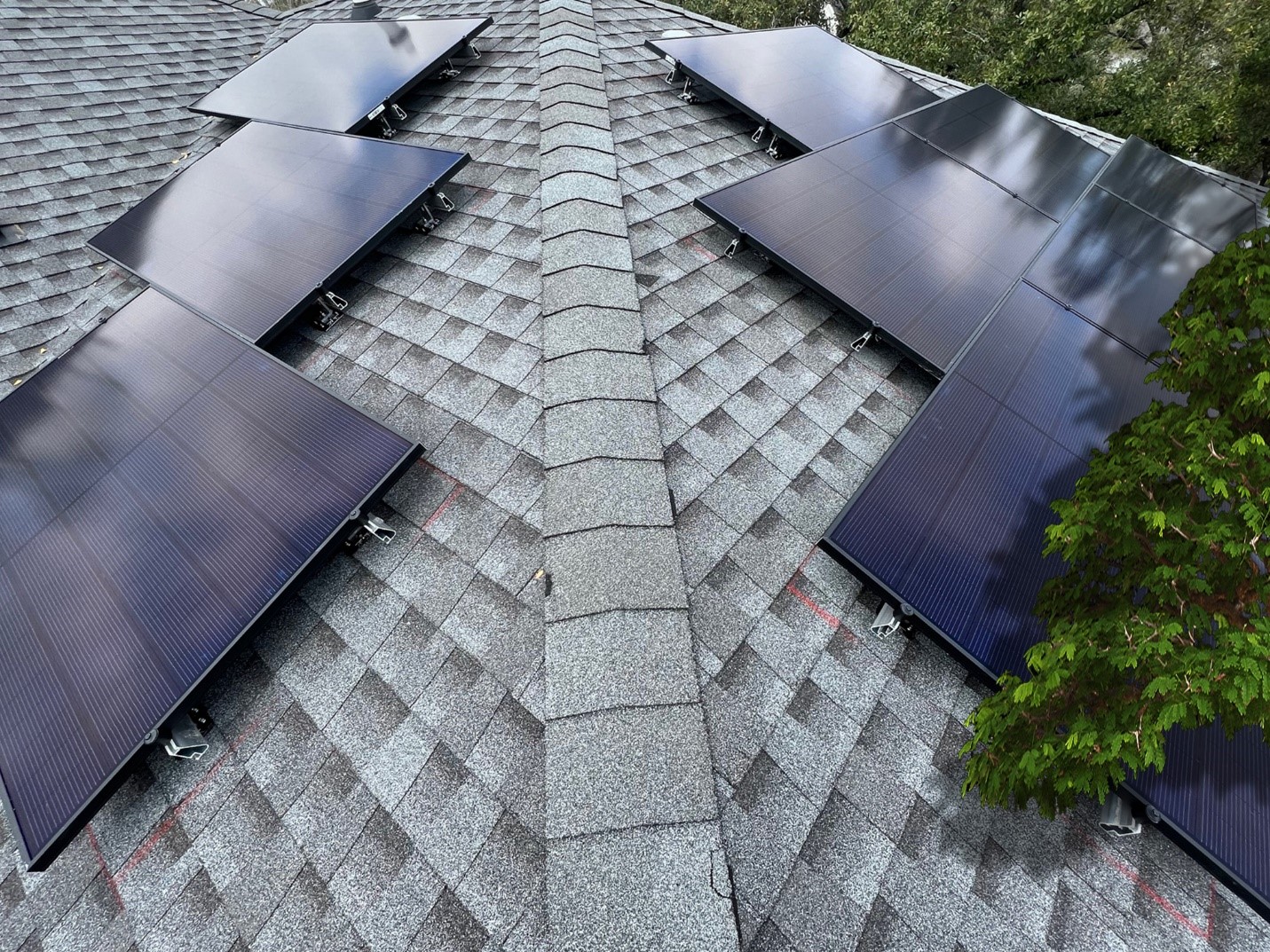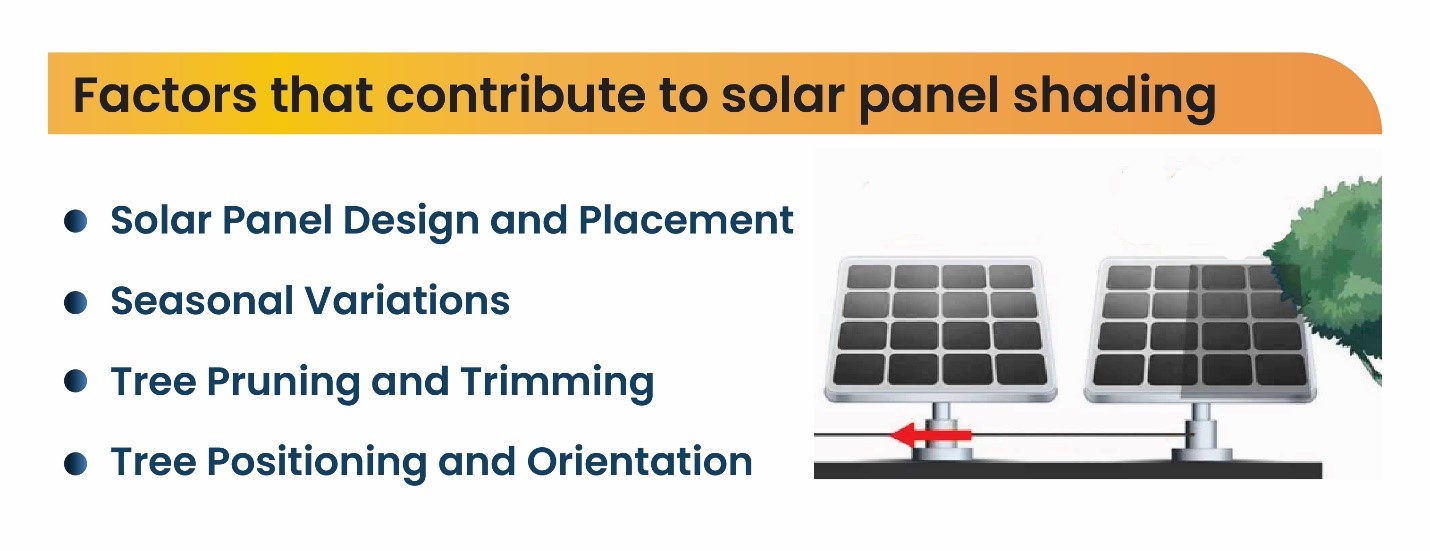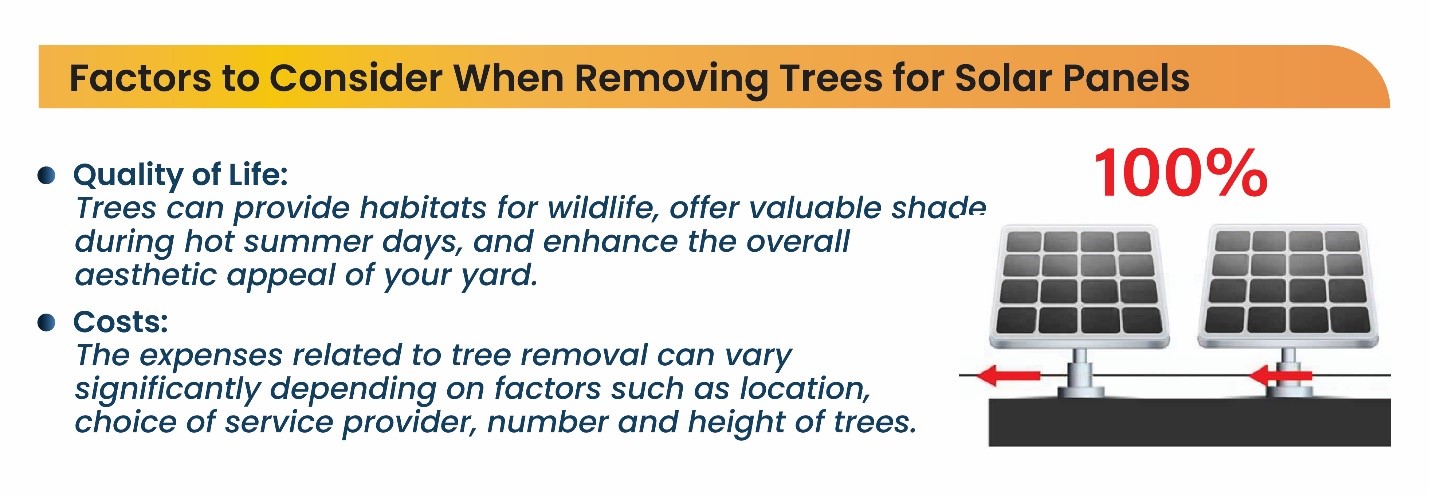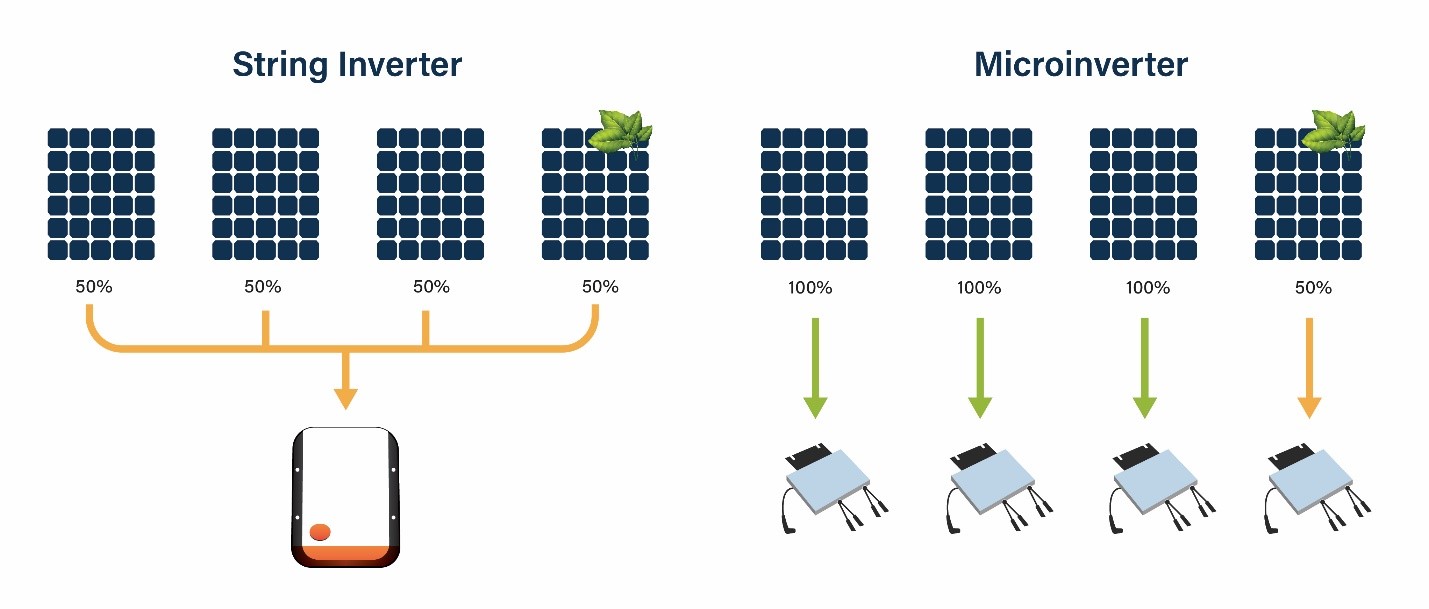How Trees Affect the Solar Performance?
Shading can impact the electricity production by your solar PV modules. Trees, buildings, and other landscapes can reduce the sunlight reaching your solar panels which can drastically decrease the performance of your solar power system. Shading from sources such as distant tree branches or clouds is known as soft shading, this can substantially reduce the sunlight reaching the solar panel cells. However, solar panel shading caused by debris or bird droppings is known as hard shading and it can severely reduce the electricity production capacity of your solar system. If just one solar cell is hard-shaded, the voltage of the solar panel can reduce to half. Over time, solar panel shading can drain a significant amount of energy from the entire system.

Solar panel systems and trees are not compatible. The branches and leaves of trees can obstruct sunlight, which can reduce the electricity generation capacity of your solar PV modules. The good news is that most homeowners with trees on their property can simply trim a few branches before installing a solar panel system. However, some homeowners may need to accept that solar power is not feasible for their property unless they remove certain trees. Many homeowners hesitate to remove trees for solar power production because it doesn’t seem like an eco-friendly and cost-effective solution. However, the overall benefits of removing trees to install solar panels might be worthwhile.
Important Points To Remember:
- Solar panels have an interconnected system, where one solar cell is connected to another through intricate wiring. When the efficiency of one panel is lower or higher than the others, it can impact the performance of the surrounding panels as well.
- The shading of solar panels depends on seasonal change.
- The presence and characteristics of trees near your solar panels can have a significant impact on their efficiency.
- By choosing a location where trees won’t cast shadows on the panels, you can ensure maximum sun exposure and optimal energy generation.
- According to a report from the American Forests, a single tree can store approximately 0.6 metric tons of carbon dioxide over its lifetime.
What is in this article?
- Shading and its Impact on Solar Panel Performance
- Consider the Location of Trees Before Solar Installation
- Environmental Impacts of Removing Trees for Solar Installation
- Factors to Consider When Removing Trees for Solar System Install
- Solar Solutions for Those Who Don’t Want to Remove Trees
- How to deal with Solar Panel Shading?
Shading and its Impact on Solar Panel Performance
Solar panels operate best when they receive direct and unobstructed sunlight. Therefore, any shading caused by trees can hinder their ability to generate maximum energy. Even partial shading on a small portion of your panels can affect the overall efficiency of your entire system. This happens because solar panels have an interconnected system, where one solar cell is connected to another through intricate wiring. When the efficiency of one panel is lower or higher than the others, it can impact the performance of the surrounding panels ultimately affecting the energy output of your entire solar PV system.
Let’s explore some factors that contribute to solar panel shading:
1. Solar Panel Design and Placement:
Carefully considering the design and placement of your solar panels is crucial in reducing the effects of shading. One effective approach is to optimize the orientation and tilt angle of the panels. This can help mitigate solar panel shading caused by trees or other obstructions, either partially or completely.
Additionally, integrating microinverters or power optimizers into each solar panel allows them to operate independently. This means that even if one panel is shaded, the others can continue to generate power efficiently, reducing overall energy loss caused by solar panel shading.
2. Seasonal Variations:
One of the factors that can contribute to solar panel shading is seasonal changes. For instance, during the winter season, there is typically less solar panel shading as compared to the summer months. Because Sun sets quite low in the sky during winter season.
It is crucial to consider these seasonal and climatic changes when assessing the shade patterns created by trees. By doing so, you can determine whether trees are impacting the performance of your solar panels.
3. Tree Pruning and Trimming:
Proper pruning and trimming of trees can help reduce the issue of solar panel shading to some extent. To do this, consider trimming branches that directly cast shadows on your solar panels.
However, it is important to consult with a professional arborist or tree specialist before undertaking any work on your trees. Hiring professionals for tree pruning and trimming ensures that the task is carried out safely and correctly.
4. Tree Positioning and Orientation
The presence and characteristics of trees near your solar panels can have a significant impact on their efficiency. Both the position and height of the trees play a crucial role in casting shadows and reducing the effectiveness of your solar system.
For example, trees located on the eastern or western side of your solar panels can create shadows during specific times of the day, such as sunrise and sunset. Conversely, trees on the southern side of your panels can cast consistent shading throughout the day as the sun moves across the sky.
Before installing solar panels, it is essential to evaluate the trees surrounding your home or business. Moreover, take into account the height and proximity of trees to your solar system. This evaluation will provide a better understanding of the shading patterns and help determine how much energy you can generate without removing any of your beloved trees.

Consider the Location of Trees Before Solar Installation
When installing solar panels, it is important to assess nearby trees before determining the ideal location. By considering the position of the trees and their growth potential, you can select a suitable site that achieves two goals:
1. Minimize solar panel shading issues:
Evaluating the trees helps you avoid potential shading problems that could negatively impact the performance of your solar panels. By choosing a location where trees won’t cast shadows on the panels, you can ensure maximum sun exposure and optimal energy generation.
2. Maximize solar energy production:
Taking into account the position and growth pattern of the trees allows you to identify an ideal spot that maximizes solar energy production. By selecting a site where trees won’t obstruct sunlight throughout the day, you can harness more solar power and increase the efficiency of your solar panels.
It is important to note that while trees can affect solar panel performance, they also offer significant environmental benefits. They contribute to cleaner air by reducing carbon dioxide levels, making them valuable assets to your property. Therefore, it is advisable to carefully consider your options before making any decisions regarding tree removal.
Environmental Impacts of Removing Trees for Solar Panels Installation:
According to a report from the American Forests, a single tree can store approximately 0.6 metric tons of carbon dioxide over its lifetime. When a tree is removed to install residential solar PV modules, the total carbon dioxide emission associated with this process are about 11.5 metric tons.
Removing a tree would only make sense from a carbon reduction perspective, if the net reduction in CO2 emissions exceeds 11.6 metric tons. At first, this may seem like a large amount, but let’s consider the benefits of installing a 6-kW solar panel system.
A 6-kW system can generate a minimum of 6,000 kilowatt-hours (kWh) of electricity per year for 30 years. Over this period, it would produce over 180,000 kWh of CO2 emission-free electricity. According to the Environmental Protection Agency (EPA), this is equivalent to reducing 127 metric tons of CO2 emission over 30 years.
If we subtract the initial 11.6 metric tons of CO2 emission needed to install the panels from the 127 metric tons of CO2 benefits they provide, we get a net benefit of 115.4 metric tons of CO2 offset. This is equivalent to planting more than 100 trees.
Factors to Consider When Removing Trees for Solar Panels Install
You need to take into account other factors as well besides the environmental benefits before removing trees from your property for solar panel installation. Here are a few things to keep in mind to address solar panel shading while cutting down trees.
1. Quality of Life:
There are several benefits associated with keeping trees. Trees can provide shade for wildlife, offer valuable shade during hot summer days, and enhance the overall aesthetic appeal of your yard. These “quality of life” advantages can depend on personal preferences and can influence your decision. While it is understandable to be hesitant about losing these benefits, many people find that the environmental and financial advantages of solar energy outweigh the drawbacks of tree removal.
2. Cost:
The expenses related to tree removal can vary significantly depending on various factors. These factors may include location, choice of service provider, number, and height of trees. The cost of tree removal can range from $200 to $2,000. Removing trees before installing solar panels may increase the initial expenditure but the savings you accumulate on your electricity bills can help recover that additional cost rapidly.

Solar Solutions for Those Who Don't Want to Remove Trees
If removing trees is not desirable or feasible for you, there is an alternative solution that allows you to go solar without installing solar panels on your property. This solution is known as community solar.
Community solar enables you to purchase electricity bill credits from local solar farms in your area. By subscribing to a community solar program, you can contribute to the development of renewable energy projects in your community. This will allow you to save about 5 to 10 percent on your electricity bill without disrupting your electricity service. Community solar is gaining popularity rapidly, although it may not be available in every state.
How to Deal with Solar Panel Shading?
Consider installing micro-inverters rather than central inverters:
Micro-inverters are a pricier option as compared to central inverters. However, they offer significant advantages, especially if your roof faces shade or has a complex shape. The way, traditional Christmas lights connected in series fail when one bulb goes out, similarly solar panels connected to a central inverter face the same problem. If a single panel is shaded, it can disrupt the entire string of panels, leading to a significant loss of electrical supply. This occurs because the central inverter optimizes the output based on the weakest link in the chain. However, micro-inverters operate differently.
In a system with micro-inverters, if one solar panel is shaded, it only has a minor impact on the overall system. This is because micro-inverters enable each panel to function at its maximum potential. Consequently, the performance of one panel does not drag down the entire solar system.

Contact Solar SME:
Trees can have a significant impact on your solar panel performance. With proper design, placement, and maintenance, our professional team can help prevent any energy loss by your solar PV modules.
To gain energy independence and maximize your solar power production through solar panels, contact Solar SME. We offer the most efficient panels in the market. We’ll ensure you get the most out of your solar system, regardless of the trees on your property.
